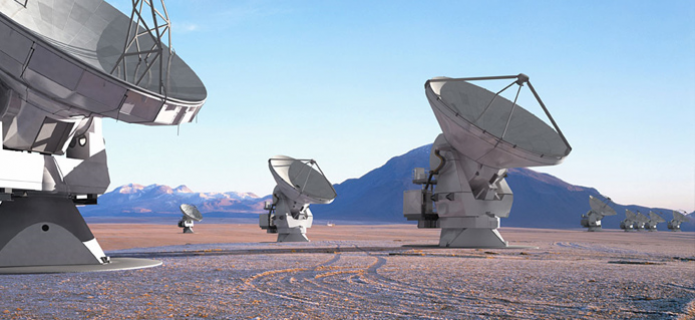Europe and US to collaborate on the design and development of a giant radio telescope in Chile
High Goals for the Atacama Large Millimeter Array (ALMA)
Representatives from the U.S. and Europe signed an agreement today in Washington to continue collaboration on the first phase of a giant new telescope project. The telescope will image the Universe with unprecedented sensitivity and sharpness at millimeter wavelengths (between the radio and infrared spectral regions). It will be a major step for astronomy, making it possible to study the origins of galaxies, stars and planets.
This project is a prime example of a truly global project, an essential development in view of the ever-increasing complexity and cost of front-line astronomical facilities. The U.S. side of the project is run by the National Radio Astronomy Observatory (NRAO), operated by Associated Universities, Inc. (AUI) under a cooperative agreement with the National Science Foundation (NSF). The European side of the project is a collaboration between the European Southern Observatory (ESO), the Centre National de la Recherche Scientifique (CNRS), the Max-Planck-Gesellschaft (MPG) , the Netherlands Foundation for Research in Astronomy (NFRA) and Nederlandse Onderzoekschool Voor Astronomie (NOVA), and the United Kingdom Particle Physics and Astronomy Research Council (PPARC) .
The Europe-U.S. agreement signed today may be formally extended in the very near future to include Japan, following an already existing tripartite declaration of intent.
Dr. Robert Eisenstein, NSF's Assistant Director Mathematical and Physical Sciences, called the project "a path-breaking international partnership that will open far-reaching opportunities for astronomical observations. This array would enable astronomers to explore the detailed processes through which the stars and planets form and give us a vastly improved understanding of the formation of the first galaxies in the very early universe." Eisenstein welcomed the collaboration with Europe and Japan's interest in becoming a major partner.
Speaking on behalf of the European Signatories, Prof. Riccardo Giacconi, Director General of the European Southern Observatory (ESO) , one of the signatories to the new astronomy project, described the new project as "absolutely fantastic and farsighted - a major ground-based astronomical observatory for the 21st century. It will open up a key region of the electromagnetic spectrum to study the very early universe and the interstellar clouds where the stars and planets are born".
The new telescope will be located in the Atacama desert of northern Chile, and has been given the name ALMA, for "Atacama Large Millimeter Array". This land has been given in concession to CONICYT (The Chilean National Commission for Science and Technology) last year by the "Ministerio de Bienes Nacionales" (Ministry of National Assets). It has also been declared a national reserve for science by President Frei because of its unique capabilities for astronomical research.
ALMA will be a revolutionary telescope, operating at millimeter and submillimeter wavelengths and comprised of an array of individual antennas each 12 meters in diameter that work together to make precision images of astronomical objects. The goal of the ALMA Project is an array of 64 antennas that can be positioned as needed over an area 10 km in diameter so as to give the array a zoom-lens capability.
Dr. Paul Vanden Bout, Director of the U.S. National Radio Astronomy Observatory , emphasized the technical capabilities needed for the array: "The ALMA Project involves development of a variety of fundamental technologies including amplification of faint cosmic signals using superconducting receivers and ultrafast digital data processing, technologies that will enhance many related areas of scientific research".
This MOU commits the Signatories to collaborate in a three-year Design and Development Phase 1 for a joint project. In the U.S., an amount of US $26 million has been approved for this phase, and in Europe, DM 28 million (15 million EURO). Two prototype 12-meter antennas will be constructed as part of Phase 1.
The MOU also commits the signatories to work towards obtaining approval and all necessary funding for collaborative participation in a 50-50 U.S.-European partnership for the ALMA construction and operation phase (Phase 2).
It is hoped that full approval of the project can be obtained by early 2001. Construction will then take much of the decade, with limited operations to begin in 2005 and the full array becoming operational by 2009. The telescope will be jointly operated by the U.S. and Europe for the benefit of their respective scientific communities.
Japanese astronomers have also been working towards a project of this kind, the Large Millimeter and Submillimeter Array (LMSA), and have recently decided to merge the LMSA in a collaboration with Europe and the U.S. Three-way meetings have already taken place, and the Europe-U.S. MOU signed today may be formally expanded to include Japan, offering the prospect of an even more capable array.
The host state, Chile, has expressed the interest of its scientific community to be substantially involved in this project, and still other countries have indicated a desire to join. ALMA may ultimately turn out to become the first truly global astronomical project.
